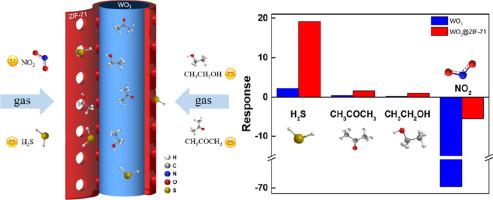Solid State Ionics ( IF 3.0 ) Pub Date : 2020-04-21 , DOI: 10.1016/j.ssi.2020.115278 Ying Zhou , Tingting Zhou , Yipeng Zhang , Li Tang , Qing Guo , Mingfeng Wang , Changsheng Xie , Dawen Zeng

|
Core-shell heterostructures of metal oxide semiconductor (MOS) and metal organic framework (MOF) improve gas-sensing properties due to the MOF's molecular sieving effects. However, the selection of MOF is limited by the requirement of identical metal element in MOF to that in MOS, which is crucial for valid interface adhesion. In this paper, WO3@ZIF-71 (zeolitic imidazolate framework) structure with different metal elemental components (W and Zn) was fabricated by a step-by-step (SBS) approach. As a result, ZIF-71 was uniformly coated on the surface of WO3. In order to explore the influence of ZIF-71 (pore size: 4.8 Å), the gas sensitivity of WO3 and WO3@ZIF-71 were tested. Different kinetic diameters gases: H2S (3.62 Å), CH3COCH3 (4.6 Å), CH3CH2OH (4.53 Å), NO2 (5.8 Å) were selected as testing gas. Gases with small molecules (H2S, CH3COCH3 and CH3CH2OH) can pass through the membrane of ZIF-71 and contact with WO3, while larger ones (NO2) were blocked outside the membrane. Excitingly, the response of WO3@ZIF-71 toward H2S gas was significantly improved, which soars from 2.24 of 20 ppm for pure WO3 to 19.12 for H2S at 250 °C, increased about 9 times. These results indicate that the MOS@MOF core-shell structure can be synthesized by the SBS method without the restriction of the same metal elements in MOS and MOF, which is also an effective approach to regulate the selectivity and sensitivity of the MOS@MOF gas sensor.
中文翻译:

具有增强的对H 2 S气体的响应和选择性的核壳花状WO 3 @ ZIF-71的合成
金属氧化物半导体(MOS)和金属有机骨架(MOF)的核-壳异质结构由于MOF的分子筛效应而提高了气敏特性。但是,MOF的选择受到MOF中与MOS中相同金属元素的要求的限制,这对于有效的界面粘合至关重要。本文采用分步法(SBS)制备了具有不同金属元素(W和Zn)的WO 3 @ ZIF-71(沸石咪唑酸酯骨架)结构。结果,ZIF-71均匀地涂覆在WO 3的表面上。为了探究ZIF-71(孔径:4.8)的影响,测试了WO 3和WO 3 @ ZIF-71的气体敏感性。不同动力学直径的气体:H 2选择S(3.62Å),CH 3 COCH 3(4.6Å),CH 3 CH 2 OH(4.53Å),NO 2(5.8Å)作为测试气体。具有小分子的气体(H 2 S,CH 3 COCH 3和CH 3 CH 2 OH)可以穿过ZIF-71的膜并与WO 3接触,而较大的气体(NO 2)则被阻挡在膜外。令人兴奋的是,WO 3 @ ZIF-71对H 2 S气体的响应得到了显着改善,从纯WO 3的20 ppm的2.24提高到H 2的19.12。S在250°C时增加约9倍。这些结果表明,可以通过SBS法合成MOS @ MOF核-壳结构,而无需限制MOS和MOF中相同的金属元素,这也是调节MOS @ MOF气体选择性和灵敏度的有效方法。传感器。































 京公网安备 11010802027423号
京公网安备 11010802027423号